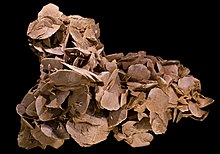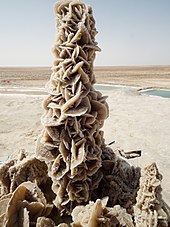
Back زهرة الصحراء Arabic Rosa del desiertu AST Пустинна роза Bulgarian Rosa del desert Catalan Sandrose German Sabla rozo Esperanto Rosa del desierto Spanish رز صحرا Persian Rose des sables French ורד מדבר (גביש) HE



A desert rose is an intricate rose-like formation of crystal clusters of gypsum or baryte, which include abundant sand grains.[1] The "petals" are crystals flattened on the c axis, fanning open in radiating clusters.
The rosette crystal habit tends to occur when the crystals form in arid sandy conditions,[1] such as the evaporation of a shallow salt basin. The crystals form a circular array of flat plates, giving the rock a shape similar to a rose blossom. Gypsum roses usually have better defined, sharper edges than baryte roses. Celestine and other bladed evaporite minerals may also form rosette clusters.[1] They can appear either as a single rose-like bloom or as clusters of blooms, typically ranging from pea-sized to 10 centimetres (4 in) in diameter.
The ambient sand that is incorporated into the crystal structure, or otherwise encrusts the crystals, varies with the local environment. If iron oxides are present, the rosettes take on a rusty tone.
The desert rose may also be known by the names: sand rose, Sahara rose, rose rock, selenite rose, gypsum rose and baryte (barite) rose.
- ^ a b c Desert Rose, Mindat.org